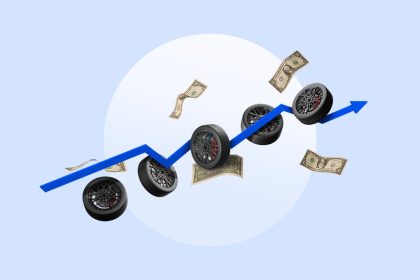Key takeaways
- Home equity is the difference between your home’s value and the amount you still owe on your mortgage. It represents the paid-off portion of your home — the amount you own outright.
- Your home equity can increase through making mortgage payments and home improvements, or as local property values rise. A decline in the local market will cause the worth of your equity stake to decrease.
- You can tap your equity and use it for various expenses, primarily via home equity loans and home equity lines of credit (HELOCs).
What is home equity and how does it work?
Home equity is the difference between the current value of your home and the outstanding balance of your mortgage — in other words, the portion of your home you own outright.
When you purchase a home, your equity stake equals your down payment or however much money you’re contributing out-of-pocket (as opposed to financing with the mortgage). So, if you put 20 percent down on a $400,000 home, you start with $80,000 worth of equity. But if you pay all cash for the home, you have $400,000 or 100 percent equity.
“As you pay down your mortgage and your home’s value hopefully increases, your equity also grows, contributing to your overall net worth,” says Linda Bell, senior writer on Bankrate’s Home Lending team. “The best part is that your equity isn’t just there collecting dust. When used the right way and for the right reasons, your home’s equity can provide you with financial flexibility and liquidity when you need it the most.”
47.4%
Percent of U.S. mortgaged homes that are “equity-rich” (meaning their outstanding loan balances total no more than half their estimated market values).
Source:
ATTOM “Q2 2025 U.S. Home Equity & Underwater Report”
How to calculate home equity
To calculate the equity in your home, follow these steps:
- Find your home’s estimated current market value. What you paid for your home a few years ago or even last year might not be its value today. If you’re just exploring home equity financing options, you can use an online home price estimator to get an idea of its worth. The most accurate assessment would be from a licensed appraiser.
- Subtract your mortgage balance. Once you know the value of your home, check your latest mortgage statement. Subtract the amount you still owe on your mortgage and any other debts secured by your home. The result is the dollar value of your home equity stake.
Calculating home equity
Five years later, your home’s value has appreciated to about $440,000, and you still owe $359,000 on your loan. At this point, you’d have $81,000 in equity ($440,000 – 359,000).
How to increase the equity in your home
Your home equity can increase in a few different ways:
- As you make mortgage payments: Every month when you make your regular mortgage payment, you’re paying down your mortgage balance and increasing your home equity stake. You can also make additional mortgage principal payments to build your equity even faster.
- When you improve your home: Increasing the value of your home also increases your home equity. (Keep in mind that some home renovations add more value than others.)
- As you ride the appreciation wave: Often (but not always), property values rise over time. This appreciation can be another way for you to build equity. Because your property increasing in value depends on several factors, such as its location and the economy, there’s no way to tell how long you’ll have to stay in your home to see a significant rise in value. The historical price data of homes in your area might give you some insight as to whether values have been trending upward or downward.
$17.6 trillion
The collective amount of home equity held by U.S. mortgage-holders at the beginning of Q2 2025. $11 trillion of that is considered “tappable,” meaning it can be borrowed against while maintaining a 20% equity stake in the home
Source:
ICE June 2025 Mortgage Monitor Report
Ways to tap your home equity
If you want to borrow against your home equity stake, there are several ways to do so.
Home equity loan
A home equity loan is a second mortgage for a fixed amount at a fixed interest rate. The amount you can borrow is based on the equity in your home, and you can use the funds for any purpose. This option can be ideal if you have a specific large expense or debt to pay off. It also comes with the stability of predictable monthly payments. If you use the funds to remodel your home, the interest might be tax-deductible.
Home equity line of credit (HELOC)
A home equity line of credit, or HELOC, is also secured by your property and works like a credit card, charging interest at a variable rate. You can withdraw as much as you want up to the credit limit during an initial draw period, usually up to 10 years; after that, withdrawals cease and you have to pay back what you’ve borrowed, plus interest. During the draw period, you can make repayments too, so that the credit line goes back up and you can withdraw again.
Cash-out refinance
A cash-out refinance replaces your current mortgage with another, bigger loan. This loan includes the balance you owe on the existing mortgage and a portion of your home’s equity, withdrawn as cash. You can use these funds for any purpose. Unlike a HELOC or home equity loan, a cash-out refi might allow you to get a lower rate on your main mortgage, depending on market conditions, and shorten the term so you can repay it sooner.
Reverse mortgage
A reverse mortgage is an option for homeowners aged 62 (or 55 with some products) and up. Unlike a HELOC or a home equity loan, the money withdrawn using a reverse mortgage doesn’t have to be repaid in monthly installments. Instead, the lender pays you each month while you continue to live in the home. The loan, plus interest, must be repaid when the borrower dies, permanently vacates or sells the home.
Shared equity agreement
A shared equity agreement is a formal arrangement between a professional investor (or investment company) and a homeowner. You can receive a lump sum of cash in exchange for a percentage of ownership in your home and/or a portion of its future appreciation; the investor receives compensation when the agreement ends on a designated date, or when you sell the home. You make no monthly payments in the meantime. These agreements cater to credit-challenged borrowers or those experiencing financial obstacles that prevent them from securing a traditional loan.
Why home equity loans are popular now
Why are people cashing in their home equity? Largely because they can.
The rapid rise in property values of the last few years has sent ownership stakes soaring. According to data analyst Cotality’s “Homeowner Equity Insights” report, in the first quarter of 2025, U.S. mortgage-holding homeowners saw their equity increase $115 billion in value year-over-year.
Also, mortgage rates have risen significantly since the pandemic years, which has impacted the cost of cash-out refinancing (previously, the most common way to tap home equity). Admittedly, HELOC and home equity loan rates have increased, as well; around 8.25 percent currently, they aren’t the bargain they once were. Still, they are more affordable than other forms of financing, such as credit cards and personal loans, and can be a little easier and quicker to obtain than a refi. Plus, you won’t need to give up your low-rate mortgage, if you have one.
Should you borrow against your home equity?
Tapping your ownership stake has several advantages, as well as drawbacks. Whether it’s a good idea for your personally depends to some degree on what you intend to use the money for.
Pros
- Lower interest rates: Since your home is the collateral for a home equity loan or line of credit, they are considered less risky for the lender. These products also tend to offer better rates than unsecured credit cards or personal loans.
- Flexible use: You can use the funds however you see fit.
- Tax benefits: If you itemize deductions on your tax returns, you might be able to deduct the interest on home equity loans or lines of credit, provided the money is used to “buy, build or substantially improve” the home.
Cons
- Risk of losing your home: Home equity debt is secured by your home, so if you fail to make payments, your lender can foreclose. If home values drop, you could also wind up owing more on your home than it’s worth. That can make it more difficult to sell your home if you need to.
- Fluctuating payments: Most HELOCs have a variable rate, which means your monthly payments could fluctuate, and you could be paying more in interest over time.
- Borrowing costs: Some lenders charge additional fees for home equity loans or HELOCs; you often have to pay closing costs as you would on a mortgage.
- Misusing the money: It’s best to use home equity to finance expenses that’ll serve as investments, like renovating a home to increase its value, starting a business or eliminating debt. Stick to needs versus wants; otherwise, you could be perpetuating a cycle of living beyond your means.
Your home’s equity can provide you with financial flexibility and liquidity when you need it the most.
— Linda Bell, Senior Writer, Bankrate
What are the potential fees involved in taking a home equity loan?
Home equity loans and HELOCs have closing costs — paid upfront, when the loan is finalized — that could add between 1 percent to 5 percent to your total borrowing costs. HELOCS generally have fewer closing costs than loans, but they often carry ongoing costs, like maintenance fees (similar to a credit card’s annual fee) or different transactional charges.
Typical fees include:
- Origination fee: Charged by the lender for creating the loan.
- Appraisal fees: The charge for a professional to calculate your home’s value.
- Credit check fees: The fee for your lender pulling your credit reports and scores.
- Title fee: The cost for the lender to verify that you do own your home.
- Prepayment penalty: A fee for paying off a HELOC or loan early.
- Transaction fee: A fee a HELOC may charge for each withdrawal.
- Annual fee: A HELOC charge that is incurred every year the account remains open, regardless of whether you make a withdrawal.
- Rate lock fee: The fee charged by a HELOC if you set a fixed instead of a variable interest rate on all or part of your balance
To minimize the fees you pay, it’s important to compare lenders’ offers for the fees they have, the amounts they charge, and if any of these are negotiable.
What can you use home equity funds for?
Here are some of the most common reasons homeowners leverage their equity — that is, borrow against it:
- Finance home improvements: You can use your equity to reinvest in your home by using the cash for a renovation. If the money goes towards upgrading the home and you itemize deductions, you could deduct the interest, as well.
- Settle outstanding balances: You can use a home equity loan or line of credit to consolidate debt, especially credit card balances charging double-digit interest rates, or medical expenses uncovered by health insurance.
- Get a business going: If you’re starting up a side hustle, home equity loans might offer better terms than small business loans, and be easier to qualify for.
- Build an emergency fund: A HELOC or HELoan can be a relatively quick, cost-effective way to cover sudden or unexpected expenses.
FAQ about home equity
Why we ask for feedback
Your feedback helps us improve our content and services. It takes less than a minute to
complete.
Your responses are anonymous and will only be used for improving our website.
Help us improve our content
Read the full article here
















